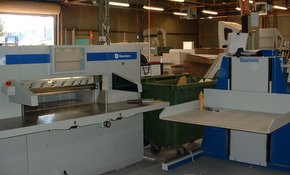
An excerpt from AP September 2020 – by Cyber Australia managing director Bernard Cheong
The offset printing landscape is ever evolving. The early adopters of the technology and lean manufacturing have been reaping the rewards and are continuing to grow. Those that were left behind have found it more difficult, and at times, impossible to keep up.
This is because digital printing is limited by click charges, also known as counter charges, which results in high costs. The key is to become competitive by using an offset press to do the on-demand jobs that other companies are printing on digital presses.
Generally, offset printing is more cost effective for runs of 200 or more.
Offset presents more value than digital as with digital, the rate of obsolescence is high, the cost of operation is high, it’s not as reliable as offset and its residual value is low. In fact, at Cyber, we believe that digital printing plays in a different space to offset as it is there as a service and not as a print production solution.
For example, the RMGT 10 TP has the most advanced functions and a short make-ready time. Its many automated features also make it easy to operate even for a less experienced operator. Labour costs account for a large percentage of total printing costs, so the RMGT 10 TP provides a huge competitive advantage. In addition to its efficiency, the RMGT 10 TP is highly productive as it is capable of one-pass colour perfecting, enabling a very low-cost system.
In my personal opinion, considering that the price of a light-duty A2 digital machine (7,000 A4 (4/4) per hour) and a heavy-duty A2 highly automated LED offset press (60,000 A4 (4/4) costs the same,
it is a no brainer in choosing offset technology.
Apart from the fast make-ready and low make-ready waste which is a given today, the introduction of dry-to-dry LED printing system had seen massive productivity and workflow enhancement especially for short and ultra-short run (digital type) production.
At Cyber, we have a range of offset presses from Ryobi MHI, which has the widest range of sheet-fed offset printing solutions in the industry. Its format sizes include the 340, 520, 680, 790, 920, a new 970, 1050, and 1130.
These solutions feature labour saving automation, quality control automation, and IoT capabilities which are increasingly becoming important features of offset in a digitised world. The machines are designed to bring out the best in their operator, in turn, making the company profitable.
If our users are profitable and growing, they will have the budget to invest and update their equipment, keeping themselves ahead of their competitors and keeping our factory busy.
However, the COVID-19 pandemic has changed the current landscape for offset printing in Australia.
In this crisis, the rate of change and transformation has and will continue to increase. The strong businesses will become stronger, while the weak get left behind. Some of our offset users are very bullish and with less competition, coupled with their high productivity and quality, they are gearing up to grow their business.
As an example, one of our users recently commented that with the installation of their latest press, what took nine hours to complete previously, they were able to get done in three hours.
Another great example is CMYKhub in Australia. In 2016, the company installed three RMGT presses, with the goal of supplying print resellers with ganged offset printed products. Ganging up printed products make shorter run lengths competitive against digital print, with the added bonus of offset quality.
Since then, the company has expanded print capacities with minimal additional costs or required floor space. The company has also emphasised better printing quality, along with focused marketing on next-day dispatch on products including business cards and flyers.
Conventional printers need to change their mindsets to start including modern-day offset machines into their line-ups. Old-school remedies based on wrong thinking do not work in the current day and age and to be ahead of the game, printers have to start running modern sheet-fed offset machines if they haven’t already. This applies to the foreseeable future as all trends point towards offset having a place in our future.
The digital version of the magazine is available here.
Comment below to have your say on this story.
If you have a news story or tip-off, get in touch at editorial@sprinter.com.au.
Sign up to the Sprinter newsletter


